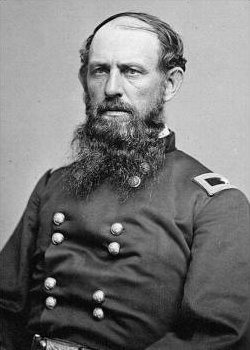Erastus B. Tyler facts for kids
Quick facts for kids
Erastus Tyler
|
|
|---|---|

Brig. Gen. Erastus B. Tyler
|
|
| Born | April 24, 1822 West Bloomfield, New York |
| Died | January 9, 1891 (aged 68) Baltimore, Maryland |
| Place of burial |
Green Mount Cemetery, Baltimore, Maryland
|
| Allegiance | |
| Service/ |
|
| Years of service | 1861–1865 |
| Rank | |
| Commands held | VIII Corps (briefly) 7th Ohio Volunteer Infantry 1st Brigade, 3rd Division, V Corps |
| Battles/wars | American Civil War |
| Other work | Postmaster of Baltimore |
Erastus Bernard Tyler (born April 24, 1822 – died January 9, 1891) was an American businessman and soldier. He became a general in the Union Army during the American Civil War. Tyler fought in many early battles in the eastern part of the war. Later, he was put in charge of defending Baltimore, Maryland. He also briefly led a group of soldiers called the VIII Corps.
Contents
Early Life and Education
Erastus B. Tyler was born in West Bloomfield, New York. He went to local schools as he grew up. When he was a young man, he moved to Ravenna, Ohio.
He later graduated from Granville College, which is now known as Denison University. At 23, Tyler started a successful business. He worked as a fur merchant in what was then western Virginia.
Serving in the Civil War
When the Civil War began, Erastus Tyler helped gather soldiers. He recruited men for the 7th Ohio Volunteer Infantry in northeastern Ohio. The soldiers chose him as their first colonel. John S. Casement became the major.
After their training, Tyler and the 7th Ohio were sent to western Virginia in August 1861.
First Battles and Challenges
At the Battle of Kessler's Cross Lanes on August 26, 1861, Tyler's new soldiers were surprised. A Confederate brigade attacked their camp. This enemy group was led by Brigadier General John B. Floyd. They had crossed the Gauley River without being seen.
Tyler's regiment was outnumbered and less experienced. They had to pull back and then scattered from the battlefield.
Leading a Brigade
In early 1862, General Frederick W. Lander gave Tyler command of a brigade. This group of soldiers was later part of a division led by James Shields and then Nathan Kimball. Tyler was promoted to brigadier general on May 14.
His brigade fought in several battles during Stonewall Jackson's Valley Campaign. These included the First Battle of Winchester. Tyler was in charge of the Union forces at the Battle of Port Republic. This was a very tough and bloody battle. Jackson's forces made Tyler's troops retreat.
Fighting with the Army of the Potomac
After some changes in the Army of the Potomac, Tyler was given a new command. He led the 1st Brigade, 3rd Division, in the V Corps. Tyler's Brigade took part in the Maryland Campaign and the Battle of Fredericksburg. They also marched in the difficult Mud March.
At Fredericksburg, his troops were part of attacks on Confederate positions at Marye's Heights. These attacks were not successful. Tyler was wounded and lost many soldiers in the fifth wave of Union attackers.
In the spring of 1863, Tyler fought again at the Battle of Chancellorsville. His brigade helped protect the right side of the Union III Corps. They stopped an attack by a Georgia brigade led by Alfred Colquitt. The fighting happened in thick woods, making it hard to see. Tyler's soldiers kept fighting until they ran low on ammunition. Confederate reinforcements then pushed back the Union right side.
Defending Baltimore
Soon after the Battle of Chancellorsville, most of Tyler's soldiers left the army. Their time of service was over. Without a command in the field, Tyler went to Washington D.C. to wait for new orders.
In June, he was put in charge of defending Baltimore, Maryland. He stayed there for the rest of the war. He also married a local woman in Baltimore. For a short time, from September 28 to October 10, 1863, he commanded the VIII Corps.
During the Battle of Monocacy in July 1864, Tyler led two regiments of new soldiers. These soldiers were called "Hundred Days Men." They successfully stopped many Confederate attempts to capture the Jug Bridge on the Baltimore Pike. This bridge was very important. It protected the Union army's far right side. It was also the path the Union army used to retreat toward Baltimore.
As the war ended, Tyler was recognized for his brave service. He received the brevet rank of major general. This honor was given in March 1865. He left the army on August 24, 1865.
Life After the War
After the war, Erastus Tyler and his wife stayed in Baltimore. They started a family there. He became well-known in society. He also served a term as the city's postmaster, which was an important public job.
Erastus Tyler passed away at age 68. He was buried in Baltimore's Green Mount Cemetery.

